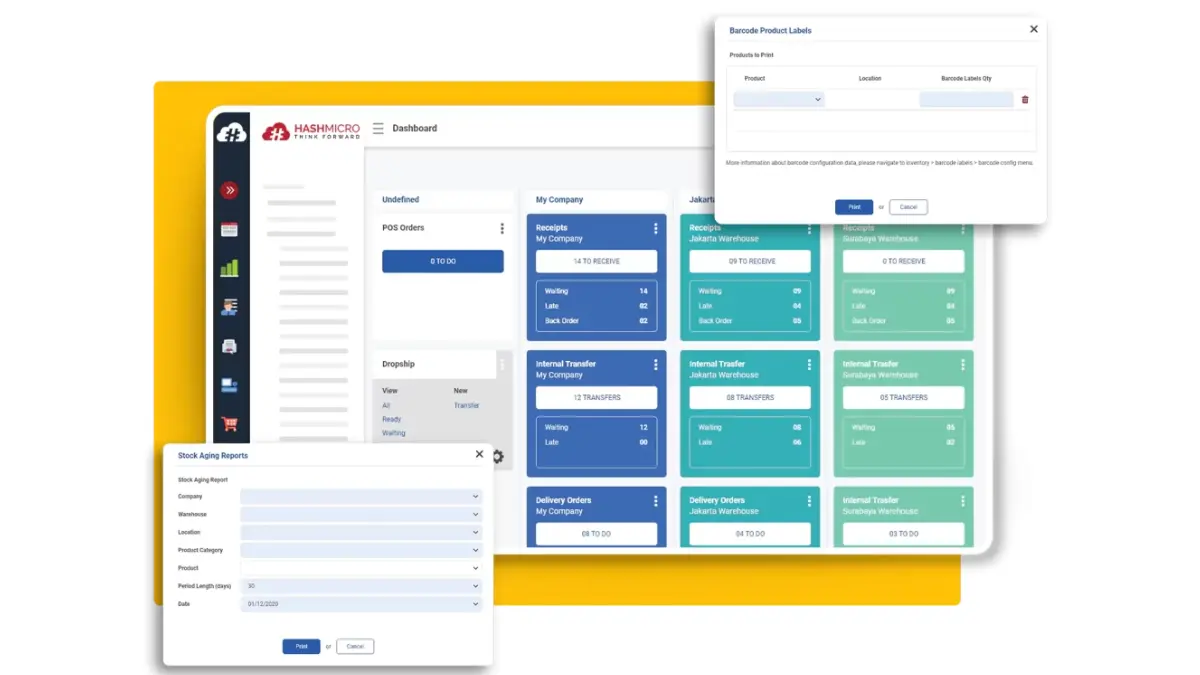Uy, kumusta! Efficient inventory management has become crucial for Filipino business owners to ensure customer satisfaction while controlling operational costs. A key component is safety stock, often underestimated but vital for effective inventory management.
Safety stock prevents stockouts during unexpected demand spikes or supply chain disruptions, maintaining smoother operations. Implementing a proper safety stock strategy shields your business from unforeseen challenges and supports business continuity. Keep reading to discover how safety stock can elevate your inventory management approach.
Key Takeaways
|
Table of Contents

What is Safety Stock Inventory?

Safety stock refers to the extra quantity of items stored to prevent stockouts caused by unpredictable demand or supply delays. It acts as a crucial buffer, ensuring your business consistently meets customer orders even during unexpected disruptions. Although it may seem like excess inventory, safety stock is essential for maintaining smooth operations.
For businesses in the Philippines, especially those relying on local and international suppliers, safety stock is even more critical due to common disruptions like shipping delays and transport strikes. Implementing safety stock minimizes these risks, ensuring your business remains efficient and responsive to customer needs.
Importance of Safety Stock Inventory
One of the main reasons businesses maintain safety stock is to protect against sudden demand spikes or supply chain disruptions. These occurrences are common, and without a safety stock buffer, businesses might find themselves unable to fulfill customer orders on time, leading to dissatisfaction and lost revenue.
By having safety stock in place, you create a cushion that absorbs the impact of these fluctuations, ensuring smoother operations. Safety stock also ensures that you don’t run into costly situations like stockouts, where orders can’t be fulfilled, and administrative efforts pile up in trying to rectify the issue.
Avoiding these scenarios not only keeps customers happy but also reduces the stress and extra work for your team. This, in turn, leads to a more streamlined and cost-effective inventory management process.
How Safety Stock Improves Inventory Management
Why Businesses Need Safety Stock Inventory
Businesses, especially in the Philippines, require safety stock for several important reasons. First, it helps prevent stockouts, which can result in lost sales and dissatisfied customers, ultimately harming both revenue and reputation.
Second, safety stock compensates for forecast inaccuracies. Even with advanced forecasting tools, customer demand can be unpredictable, and safety stock serves as a backup when demand deviates from expectations. Lastly, it helps manage supplier reliability issues by providing a buffer, allowing smooth operations when suppliers face delays.
How to Calculate Safety Stock
To dive deeper into calculating safety stock, choosing a method based on your business needs and operational complexity is essential. Below are several calculation methods explained:
1. Fixed Safety Stock Calculation
This is the simplest method where a fixed number of units is held as a buffer based on past demand trends. Businesses with stable demand patterns often rely on this approach.
- Example: If your business sells 100 units per week with an average lead time of two weeks, maintaining an additional 50 units as safety stock can cover any unexpected demand fluctuations.
2. Time-Based Safety Stock Calculation
This method calculates safety stock based on lead time. It multiplies the average demand during lead time by a buffer to account for potential delays.
- Formula:

- Example: If the average demand is 100 units per week and the lead time is four weeks, this method ensures enough stock to prevent shortages during replenishment.
3. Advanced Calculation Using Variability
For businesses dealing with uncertainty in both demand and lead time, statistical models are ideal. The advanced method uses standard deviations to account for variations.
- Formula:

-
- Z: Service level factor (e.g., for a 95% service level, Z = 1.65)
- σdemand: Standard deviation of demand during lead time
- Lead Time: Average replenishment time
This method is more precise but requires accurate historical data to calculate demand and lead time deviations.
4. Safety Stock Formula for Demand and Lead Time Variability
This advanced safety stock formula considers demand and lead time variability, offering a more robust safety stock level.
- Formula:

This method is suitable for businesses with fluctuating supply and demand, ensuring they maintain optimal inventory levels.
The choice of safety stock calculation method depends on factors like inventory turnover, lead time reliability, and demand variability. For Filipino business owners, implementing these methods can optimize stock levels, reduce costs, and ensure customer satisfaction by preventing stockouts.
Factors to Consider When Determining Safety Stock Levels

When determining safety stock levels, it’s essential to account for several critical factors to ensure the correct balance between meeting customer demand and avoiding excessive inventory costs. The following are the key factors to consider:
- Lead Time: The duration it takes for stock to arrive after an order is placed. Longer lead times require more safety stock to cover potential delays.
- Demand Variability: If customer demand is highly unpredictable, maintaining a higher level of safety stock is necessary to prevent stockouts.
- Service Level: This represents the percentage of demand you aim to meet without stockouts. A higher service level increases the need for safety stock.
- Supplier Reliability: Inconsistent supplier performance can also influence how much safety stock you maintain to account for potential delays or shortages.
Considering these factors helps businesses optimize their inventory management by maintaining the right amount of safety stock to meet customer needs while controlling costs. Utilizing an e-commerce inventory management software further enhances this process by providing real-time insights and automation to streamline operations.
Also read: Best Practices for Restaurant Inventory Management for Business
Common Challenges and Risks in Managing Safety Stock
While safety stock is crucial, managing it effectively involves several challenges that can impact both inventory costs and operational efficiency. One of the most common risks is overstocking, which leads to increased holding costs and inefficient use of capital. Conversely, understocking leaves businesses exposed to stockouts, negating the purpose of maintaining a buffer.
Challenges in managing safety stock include:
- Overstocking: Excess inventory results in higher holding costs, tying up working capital unnecessarily.
- Understocking: Insufficient safety stock increases the risk of stockouts, leading to lost sales and dissatisfied customers.
- Infrequent Adjustments: Failing to regularly adjust safety stock levels as demand patterns or lead times change can render the buffer ineffective.
- Setting Levels Too High: Excessively high safety stock levels can lead to waste, especially if demand forecasts are inaccurate or fluctuate significantly.
Safety stock levels should be reviewed and adjusted regularly to avoid these pitfalls based on updated demand forecasts, lead times, and supply chain conditions. Proper management ensures that the buffer remains optimal without incurring excessive costs or risks.
Best Practices for Managing Safety Stock Inventory
To effectively manage safety stock, businesses should regularly monitor inventory levels and adjust based on changing demand and lead time. Continuous reviews help identify trends and ensure safety stock levels align with the current operational environment, reducing the risk of overstocking or stockouts.
These practices include:
- Monitoring Inventory Levels: Regularly track and adjust safety stock levels based on demand and lead time variability.
- Using Cloud Inventory Management Software: Leveraging real-time data and analytics tools can automate safety stock calculations and improve decision-making.
- Trend Identification: Identifying patterns in demand and lead time through regular reviews allows for timely adjustments to safety stock levels.
For Filipino business owners, using Inventory Management Software can be one of the best practices to do. Adopting these best practices can streamline operations and lead to more efficient inventory management.
HashMicro Inventory Solution

When it comes to managing inventory efficiently, HashMicro’s best inventory management software stands out from others as an all-encompassing solution designed to help businesses in the Philippines streamline their operations. This system offers the tools you need to ensure smooth inventory management while minimizing costs.
Key features of HashMicro System include:
- Automated Safety Stock Calculations: The system helps you set optimal safety stock levels based on real-time data, lead times, and demand variability, ensuring you never run out of stock or overstock.
- Real-Time Inventory Tracking: This feature provides a clear, up-to-date overview of your stock across multiple locations, allowing you to manage your inventory from anywhere at any time.
- Supplier Management: Manage your suppliers more effectively by monitoring lead times, reliability, and performance, which is crucial when determining the right amount of safety stock.
- Demand Forecasting: Using advanced algorithms, HashMicro’s system predicts future demand based on historical data, helping businesses set safety stock levels that reduce the risk of stockouts or overstocking.
By utilizing these features, Filipino businesses can optimize their inventory management processes, maintain the right balance of safety stock, and ultimately improve customer satisfaction while minimizing operational costs.
Conclusion
Safety stock is essential for maintaining smooth operations, preventing stockouts, and managing supply chain uncertainties. Filipino businesses can optimize inventory control and reduce costs by calculating and managing safety stock effectively. With HashMicro’s Inventory Management Software, you can automate this process for improved accuracy and efficiency. Ready to transform your inventory management? Try our free demo today!
Frequently Asked Questions
-
What percentage of inventory should be safety stock?
Safety stock typically ranges from 10% to 20% of total inventory, depending on factors like demand variability, lead times, and service level goals. Businesses should regularly review and adjust this percentage based on changing operational needs.
-
What is the difference between minimum inventory and safety stock?
Minimum inventory is the lowest quantity of stock required to meet demand before new orders are placed in order management. On the other hand, safety stock is extra buffer stock held to protect against unexpected demand spikes or supply chain delays.
-
What is EOQ safety stock?
EOQ (Economic Order Quantity) safety stock refers to the additional buffer stock held while using the EOQ model, which minimizes the total costs of ordering and holding inventory. It ensures availability during demand or supply uncertainties without excessive holding costs.





































